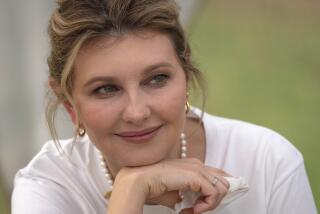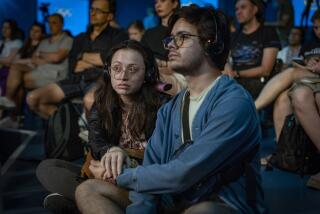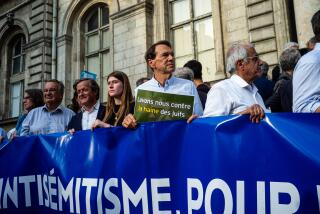Schools Begin Teaching Babi Yar Truth: Most Victims Were Jews : Ukraine: Nothing was taught about the massacres until 1966. Then classes were told only that âSoviet peopleâ died there.
KIEV, Soviet Union â The 32 pupils in Mrs. Sidnevaâs third-grade class listened with rapt attention Monday as she described how Nazi soldiers shot more than 30,000 people in two days 50 years ago in a wooded area on the edge of Kiev.
âThe Nazis hated all of us--the Ukrainians, the Russians and the Byelorussians--but who did they hate the most?â Inna M. Sidneva asked the 8- and 9-year-olds sitting erect at their desks.
Several hands shot up, and the teacher motioned to a boy sitting in the front row.
âThey hated Jews most of all,â said Vasilyok Zhenchenko, standing at attention next to his desk.
What seemed like a normal history lesson marking the anniversary of a horrible crime by invading troops was actually an unprecedented event in Ukrainian classrooms. For the first time in 50 years, children like these across the Ukraine were being taught the full story about what happened at Babi Yar.
Two decades after the massacre, teachers, following the lead of the government, still ignored the subject. When they finally started teaching it, they avoided mentioning that the big mass grave was filled mostly with bones of Jewish victims of the Nazi occupation.
They did not tell the children, as Sidneva did Monday, that on Sept. 29 and 30, 1941, 33,741 Jews--at least half of them children--were shot by Nazi sharpshooters, their bodies falling one on top of the other in the huge natural pit. Jews made up about three-quarters of the estimated total of 200,000 people finally buried there.
âI learned about Babi Yar from my parents,â said Leonid Burkatov, a dark-eyed 9-year-old wearing a blue vest. âThis is the first lesson weâve ever had in school about it.â
Sidneva, who has taught at Kiev School No. 92 for 34 years, acknowledged that in previous years, she did not give much attention to the mass executions here. âWe used to teach simply that people of the Soviet Union had died there,â Sidneva recalled. âWe never mentioned anything particular about Jews. Thatâs how we dealt with the so-called ethnic problems in the Soviet Union--we ignored them.
âItâs much better that these children know the truth,â she said. âUkrainian children will understand Jewish children better than their parents did because they will know about the historic abasement of the Jews.â
Although they had not learned in school about the history of Babi Yar--the deep ravine where Nazis executed first Jews, then prisoners of war, Gypsies and others--many of the children in the class could recite details about the horrible events that took place there.
Lida Vovochik-Blakitna, who wore a blue jumper and a white turtleneck shirt, stood up and told her classmates what she had heard the day before when her mother took her to the site of the massacre during a memorial service.
âThey had been told to take all their best things with them and go to Babi Yar,â said Lida, 9. âBut when they got there, these things were taken from them. They were stripped naked and then the Nazis started to shoot the Jews. My strongest impression from what I learned yesterday was that the Nazis did not shoot armed people but innocent, unarmed people--many of them children just like me.â
A tall boy in a jeans jacket said he had seen a movie about Babi Yar over the weekend.
âIt was about a remarkable woman who was at Babi Yar that day,â said Stanislav Bandrovsky. âBut she fainted and fell into the ravine without being shot. In the darkness, she crawled out and escaped.â
Sidneva asked the children to close their eyes and imagine what it was like for the Jews who were herded like animals to Babi Yar.
âItâs horrible isnât it?â she asked after a few moments.
âYes, it is awful,â the children said in reply as they opened their eyes.
The classroom was devoid of any of the traditional symbols of Soviet power that filled schools across the country for seven decades. Instead of the typical portrait of Bolshevik leader V. I. Lenin hung a portrait of turn-of-the-century Ukrainian poet Ivano Franko.
Although most of the children wore the traditional school uniforms--girls in the same brown or blue dresses with white lace collars and cuffs that were worn before the 1917 Bolshevik Revolution, and boys in modern blue trousers and jacket--several of the children wore street clothes.
No one wore the red bandannas that children for decades before them wore with pride as a symbol of being members of the Pioneers, a type of Communist Party for young Soviet children.
During a break, several of the children said they had never been to Babi Yar, where a monument to the tragedy has stood since 1966. The teacher urged them to take a city bus to the site and not to forget to bring marigolds with them--the Ukrainian symbol of sorrow.
The teacher referred to Babi Yar as one of the worst tragedies of World War II, which is known here as the Great Patriotic War.
âYou children are our future,â Sidneva said. âYou must do all you can do so that there will never be a war or such a tragedy here ever again.â
More to Read
Sign up for Essential California
The most important California stories and recommendations in your inbox every morning.
You may occasionally receive promotional content from the Los Angeles Times.










